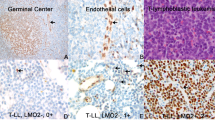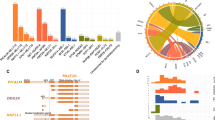Abstract
Clonal genetic aberrations in tumour cells provide critical information for the development of new diagnostic and therapeutic strategies for patients. In paediatric T-cell acute lymphoblastic leukaemia (T-ALL) chromosomal translocations are present in 30–35% of cases. HOX11 and the closely related HOX11L2 genes play a key role in T-ALL. HOX11 is aberrantly activated by either of the two chromosomal translocations, t(7;10) and t(10;14). In this study, HOX11 expression levels were measured by real-time quantitative reverse-transcriptase polymerase chain reaction. We show that leukaemic blasts from 15/76 (19.7%) paediatric T-ALL patients expressed the HOX11 gene at high level and 22/76 (28.9%) at low level, yet the reported frequency for chromosomal rearrangement of 10q24 is 4–7%. Direct cytogenetic analysis revealed that only 2/16 specimens that showed HOX11 expression exhibited abnor-malities at 10q24. These results confirm and extend our previously published findings, and implicate mechanisms other than gross chromosomal translocations for the deregulation of HOX11. Analysis of clinical outcome for the whole study group showed a trend for better outcome for patients with leukaemic blasts expressing HOX11 at high level. A statistically significant difference in clinical outcome was found in a subgroup of 20 patients treated for high-risk disease on CCG-1901 from the Children's Cancer Group, where HOX11 expression in leukaemic blasts conferred a prognostic advantage (P=0.01).
This is a preview of subscription content, access via your institution
Access options
Subscribe to this journal
Receive 12 print issues and online access
$259.00 per year
only $21.58 per issue
Buy this article
- Purchase on Springer Link
- Instant access to full article PDF
Prices may be subject to local taxes which are calculated during checkout


Similar content being viewed by others
References
Heerema NA . Cytogenetics of leukemia. Cancer Invest 1998; 16(2): 127–134.
Raimondi SC, Behm FG, Roberson PK, Pui CH, Rivera GK, Murphy SB et al. Cytogenetics of childhood T-cell leukemia. Blood 1988; 72(5): 1560–1566.
Rowley JD, Reshmi S, Carlson K, Roulston D . Spectral karyotype analysis of T-cell acute leukemia. Blood 1999; 93(6): 2038–2042.
Schneider NR, Carroll AJ, Shuster JJ, Pullen DJ, Link MP, Borowitz MJ et al. New recurring cytogenetic abnormalities and association of blast cell karyotypes with prognosis in childhood T-cell acute lymphoblastic leukemia: a Pediatric Oncology Group report of 343 cases. Blood 2000; 96(1): 2543–2549.
Look AT . Oncogenic transcription factors in the human acute leukemias. Science 1997; 278(5340): 1059–1064.
Ferrando AA, Neuberg DS, Staunton J, Loh ML, Huard C, Raimondi SC et al. Gene expression signatures define novel oncogenic pathways in T cell acute lymphoblastic leukemia. Cancer Cell 2002; 1: 75–87.
Kees UR, Lukeis R, Ford J, Garson OM . Establishment and characterization of a childhood T-cell acute lymphoblastic leukemia cell line, PER-255, with chromosome abnormalities involving 7q32-34 in association with T-cell receptor-beta gene rearrangement. Blood 1989; 74(1): 369–373.
Kennedy MA, Gonzalez-Sarmiento R, Kees UR, Lampert F, Dear N, Boehm T et al. HOX11, a homeobox-containing T-cell oncogene on human chromosome 10q24. Proc Nat Acad Sci USA 1991; 88(20): 8900–8904.
Dube ID, Kamel-Reid S, Yuan CC, Lu M, Wu X, Corpus G et al. A novel human homeobox gene lies at the chromosome 10 breakpoint in lymphoid neoplasias with chromosomal translocation t(10;14). Blood 1991; 78(11): 2996–3003.
Hatano M, Roberts CW, Minden M, Crist WM, Korsmeyer SJ . Deregulation of a homeobox gene, HOX11, by the t(10;14) in T cell leukemia. Science 1991; 253(5015): 79–82.
Lu M, Gong ZY, Shen WF, Ho AD . The tcl-3 proto-oncogene altered by chromosomal translocation in T-cell leukemia codes for a homeobox protein. EMBO J 1991; 10(10): 2905–2910.
Bernard OA, Busson-LeConiat M, Ballerini P, Mauchauffe M, Della Valle V, Monni R et al. A new recurrent and specific cryptic translocation, t(5;14)(q35;q32), is associated with expression of the Hox11L2 gene in T acute lymphoblastic leukemia. Leukemia 2001; 15(10): 1495–1504.
Ballerini P, Blaise A, Busson-Le Coniat M, Su XY, Zucman-Rossi J, Adam M et al. HOX11L2 expression defines a clinical subtype of pediatric T-ALL associated with poor prognosis. Blood 2002; 100(3): 991–997.
Mauvieux L, Leymarie V, Helias C, Perrusson N, Falkenrodt A, Lioure B et al. High incidence of Hox11L2 expression in children with T-ALL. Leukemia 2002; 16(12): 2417–2422.
Heerema NA, Sather HN, Sensel MG, Kraft P, Nachman JB, Steinherz PG et al. Frequency and clinical significance of cytogenetic abnormalities in pediatric T-lineage acute lymphoblastic leukemia: a report from the Children's Cancer Group. J Clin Oncol 1998; 16(4): 1270–1278.
Salvati PD, Ranford PR, Ford J, Kees UR . HOX11 expression in pediatric acute lymphoblastic leukemia is associated with T-cell phenotype. Oncogene 1995; 11(7): 1333–1338.
Gaynon PS, Desai AA, Bostrom BC, Hutchinson RJ, Lange BJ, Nachman JB et al. Early response to therapy and outcome in childhood acute lymphoblastic leukemia: a review. Cancer 1997; 80(9): 1717–1726.
Holt PG, Kees UR, Shon-Hegrad MA, Rose A, Ford J, Bilyk N et al. Limiting-dilution analysis of T cells extracted from solid human lung tissue: comparison of precursor frequencies for proliferative responses and lymphokine production between lung and blood T cells from individual donors. Immunology 1988; 64(4): 649–654.
Kees UR, Ford J, Price PJ, Meyer BF, Herrmann RP . PER-117: a new human ALL cell line with an immature thymic phenotype. Leukemia Res 1987; 11(5): 489–498.
Hereema N, Palmer C, Baehner R . Karyotypic and clinical findings in a consecutive series of children with acute lymphoblastic leukemia. Cancer Genet Cytogenet 1985; 17: 165–179.
Mitelman F . ISCN: an International System for Human Cytogenetic Nomenclature. Switzerland, Karger: Basel, 1995.
Kaplan E, Meier P . Nonparametric estimation from incomplete observations. J Am Statist Assoc 1958; 53: 457–481.
Peto R, Pike MC, Armitage P, Breslow NE, Cox DR, Howard SV et al. Design and analysis of randomized clinical trials requiring prolonged observation of each patient, II. analysis and examples. Br J Cancer 1977; 35(1): 1–39.
Zutter M, Hockett RD, Roberts CW, McGuire EA, Bloomstone J, Morton CC et al. The t(10;14)(q24;q11) of T-cell acute lymphoblastic leukemia juxtaposes the delta T-cell receptor with TCL3, a conserved and activated locus at 10q24. Proc Natl Acad Sci USA 1990; 87(8): 3161–3165.
Lu M, Zhang N, Ho AD . Genomic organization of the putative human homeobox proto-oncogene HOX-11 (TCL-3) and its endogenous expression in T cells. Oncogene 1992; 7(7): 1325–1330.
Smith M, Arthur D, Camitta B, Carroll AJ, Crist W, Gaynon P et al. Uniform approach to risk classification and treatment assignment for children with acute lymphoblastic leukemia. J Clin Oncol 1996; 14(1): 18–24.
Drexler HG . Review of alterations of the cyclin-dependent kinase inhibitor INK4 family genes p15, p16, p18 and p19 in human leukemia–lymphoma cells. Leukemia 1998; 12(6): 845–859.
Kees UR, Burton PR, Lu C, Baker DL . Homozygous deletion of the p16/MTS1 gene in pediatric acute lymphoblastic leukemia is associated with unfavorable clinical outcome. Blood 1997; 89(11): 4161–4166.
Ferrando AA, Look AT . Clinical implications of recurring chromosomal and associated molecular abnormalities in acute lymphoblastic leukemia. Semin Hematol 2000; 37(4): 381–395.
Watt PM, Kumar R, Kees UR . Promoter demethylation accompanies reactivation of the HOX11 proto-oncogene in leukemia. Genes Chromosomes Cancer 2000; 29(4): 371–377.
Brake RL, Kees UR, Watt PM . Multiple negative elements contribute to repression of the HOX11 proto-oncogene. Oncogene 1998; 17(14): 1787–1795.
Greer JM, Puetz J, Thomas KR, Capecchi MR . Maintenance of functional equivalence during paralogous Hox gene evolution. Nature 2000; 403(6770): 661–665.
Mann RS, Chan SK . Extra specificity from extradenticle: the partnership between HOX and PBX/EXD homeodomain proteins. Trends Genet 1996; 12(7): 258–262.
Uckun FM, Sensel MG, Sun L, Steinherz PG, Trigg ME, Heerema NA et al. Biology and treatment of childhood T-lineage acute lymphoblastic leukemia. Blood 1998; 91(3): 735–746.
Uckun FM, Sensel MG, Sather HN, Gaynon PS, Arthur DC, Lange BJ et al. Clinical significance of translocation t(1;19) in childhood acute lymphoblastic leukemia in the context of contemporary therapies: a report from the Children's Cancer Group. J Clin Oncol 1998; 16(2): 527–535.
Acknowledgements
The contributing cytogeneticists were S Schonberg, S Kerman, K Rao, J Biegel, K Theil, V Murty, D Warburton, A Murch, S Schwartz, B Hurang, M Thangavelu, R Blough, L McGavran, D Roulston, H Aviv, L McMorrow, K Richkind, S Jhanwar, B Hirsch, P Cotter, N Heerema, T Glover, S Sheldon. This work was supported by the Child Health Research Foundation and the Children's Leukaemia and Cancer Research Foundation, Western Australia, the Children's Cancer Group, Arcadia, CA, USA and partly funded by NIH Grants U10-CA79726 and CA83088.
Author information
Authors and Affiliations
Rights and permissions
About this article
Cite this article
Kees, U., Heerema, N., Kumar, R. et al. Expression of HOX11 in childhood T-lineage acute lymphoblastic leukaemia can occur in the absence of cytogenetic aberration at 10q24: a study from the Children's Cancer Group (CCG). Leukemia 17, 887–893 (2003). https://doi.org/10.1038/sj.leu.2402892
Received:
Accepted:
Published:
Issue Date:
DOI: https://doi.org/10.1038/sj.leu.2402892
Keywords
This article is cited by
-
The EphB6 receptor is overexpressed in pediatric T cell acute lymphoblastic leukemia and increases its sensitivity to doxorubicin treatment
Scientific Reports (2017)
-
Investigation of FIH-1 and SOCS3 expression in KRAS mutant and wild-type patients with colorectal cancer
Tumor Biology (2016)
-
The effect of TLX3 expression on the prognosis of pediatric T cell acute lymphocytic leukemia—a systematic review
Tumor Biology (2014)
-
NKL homeobox genes in leukemia
Leukemia (2012)



